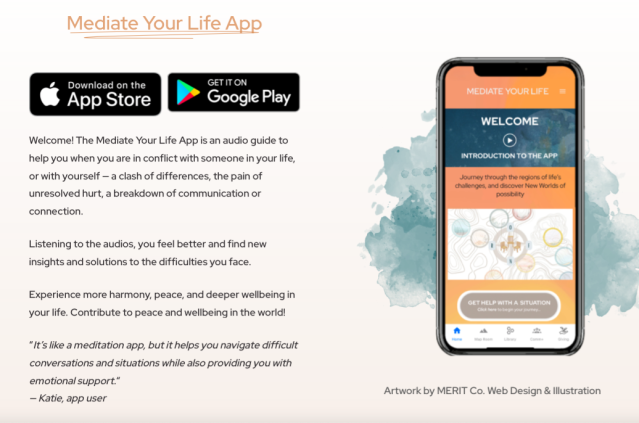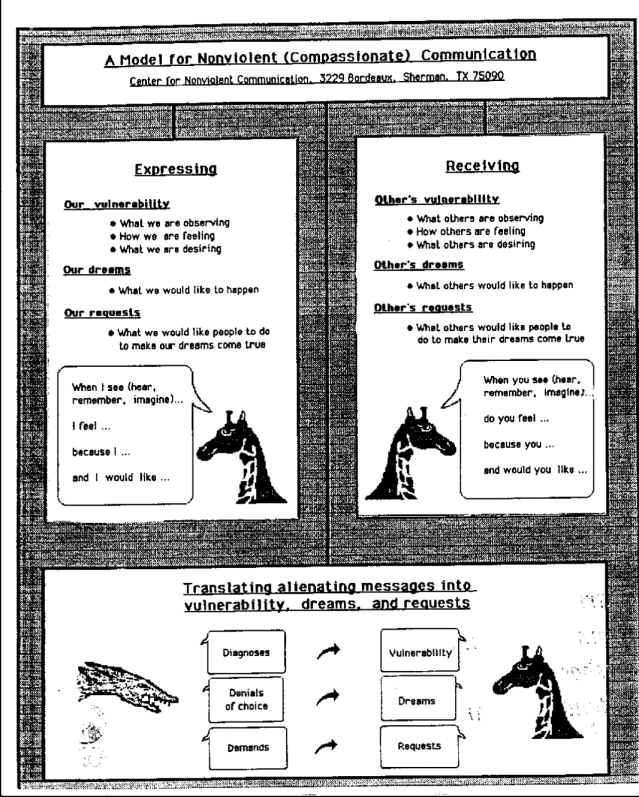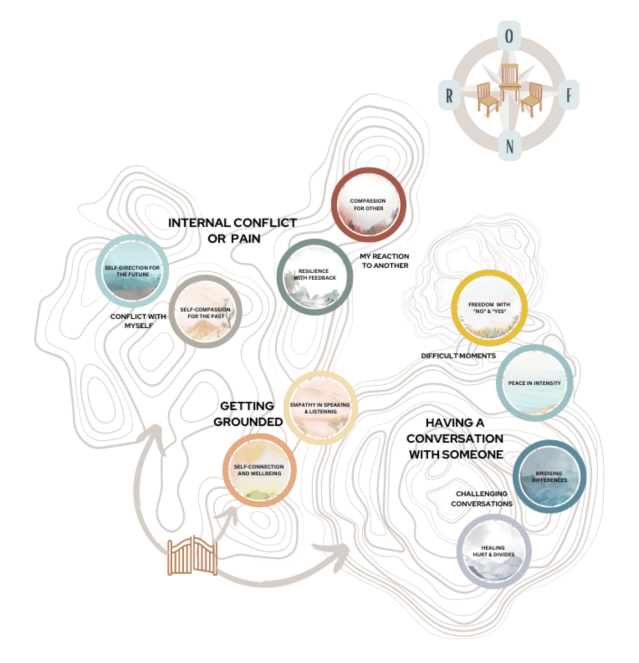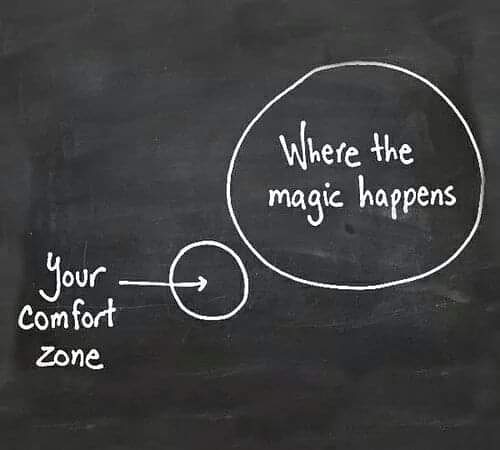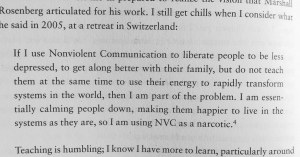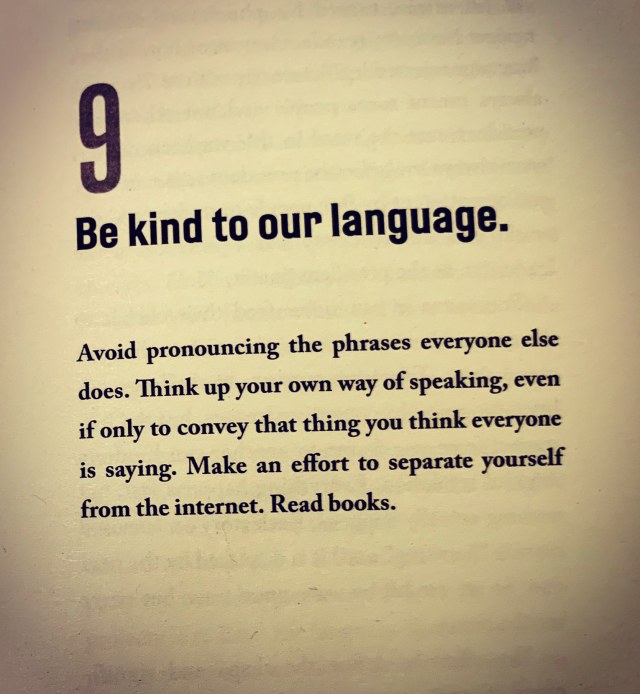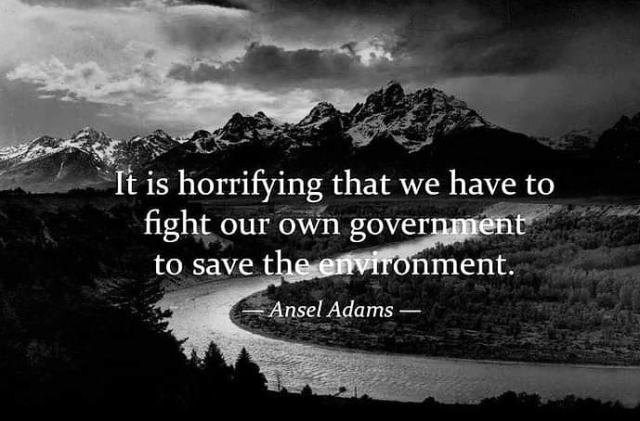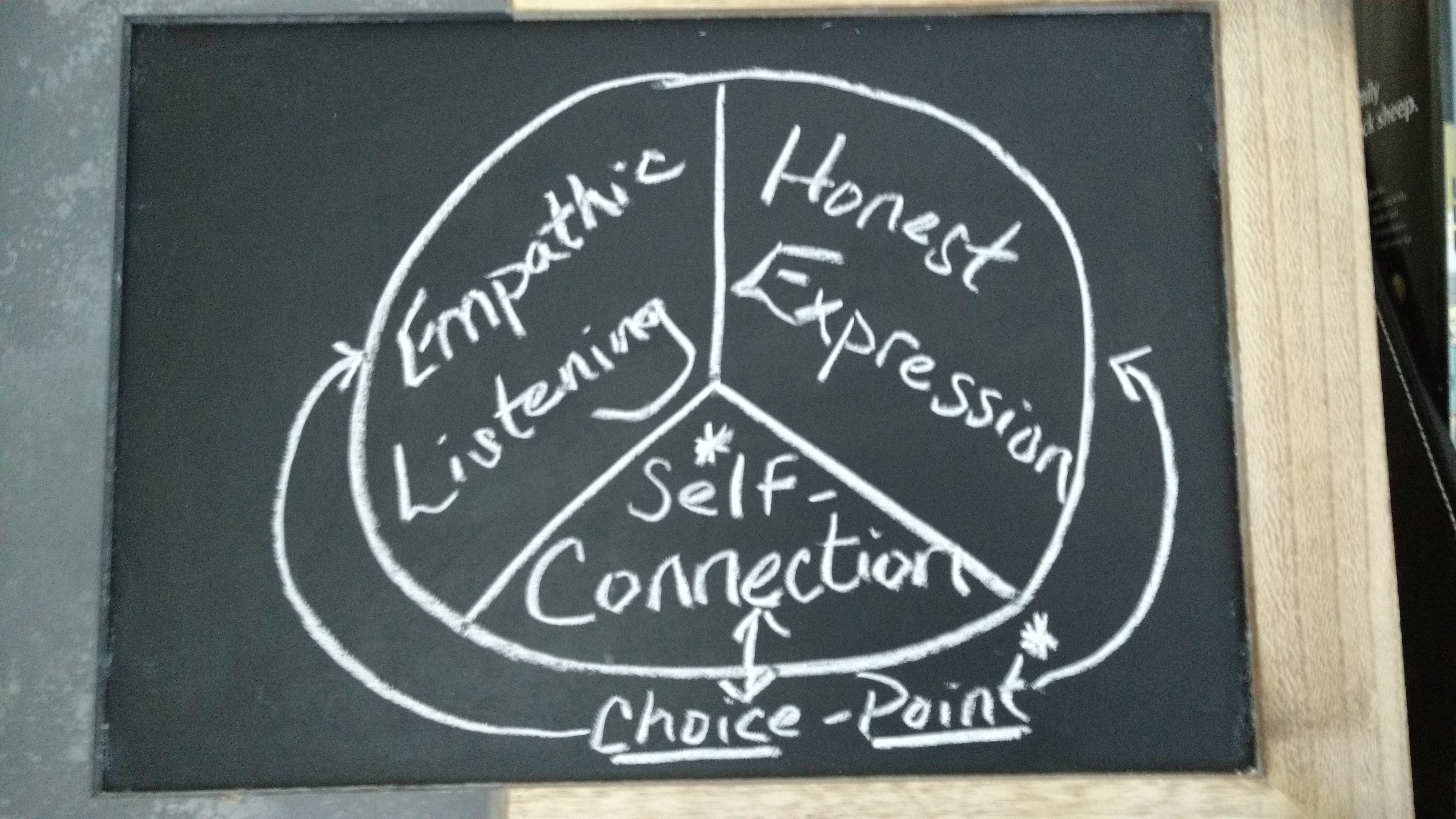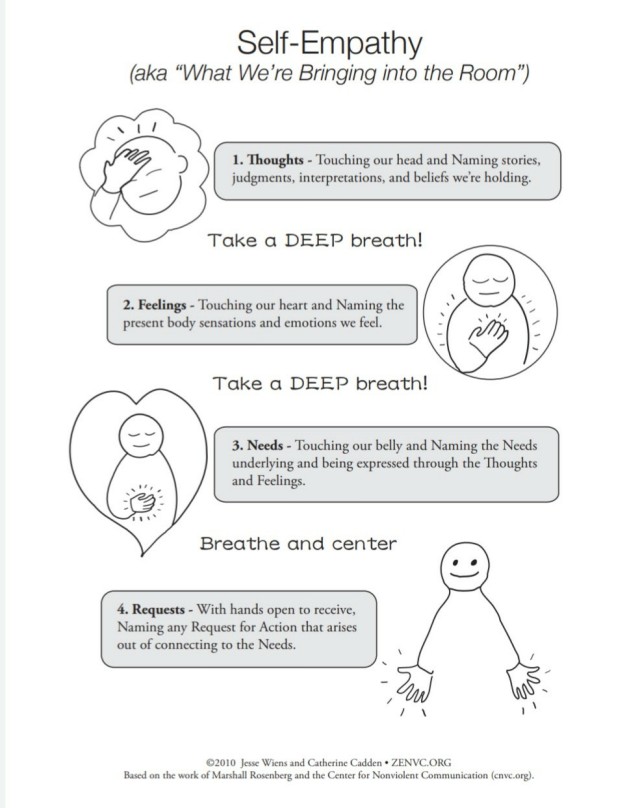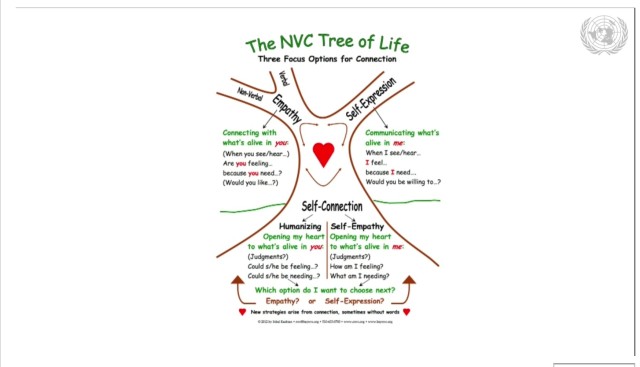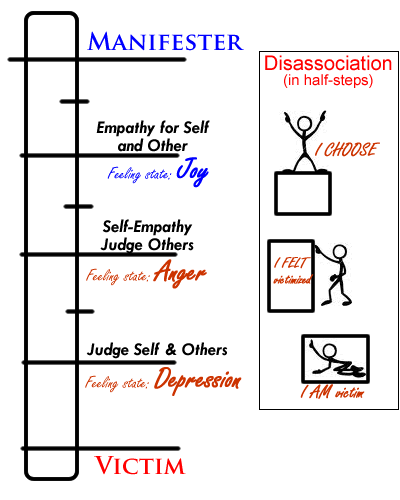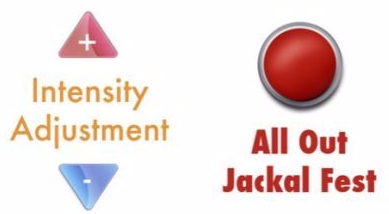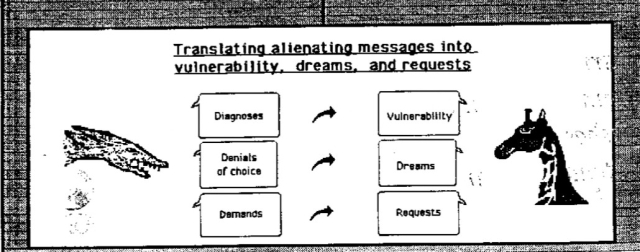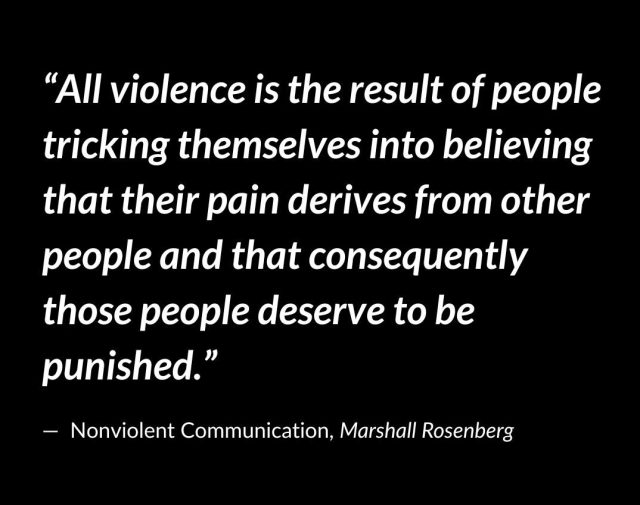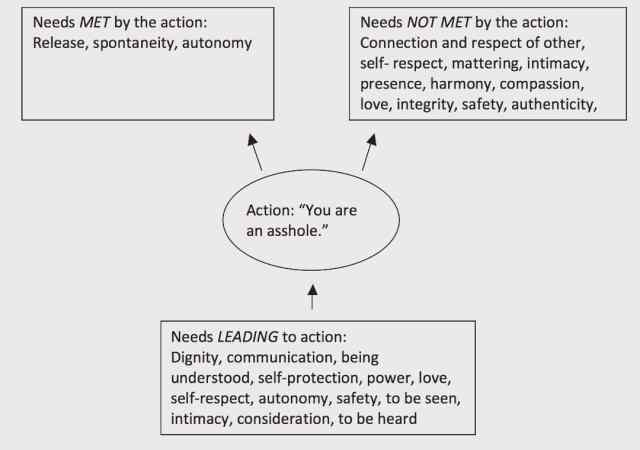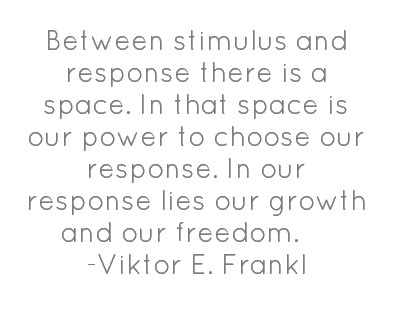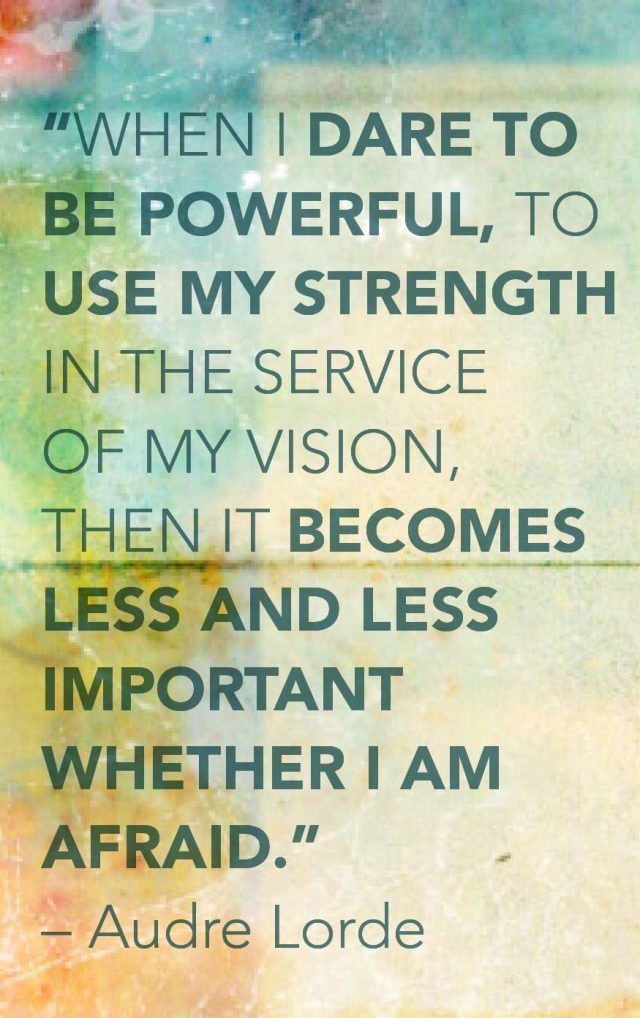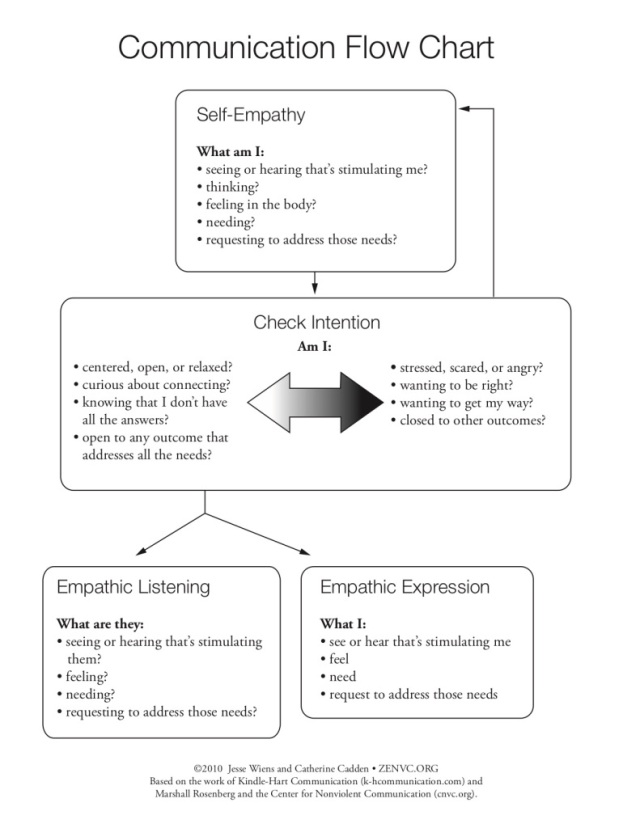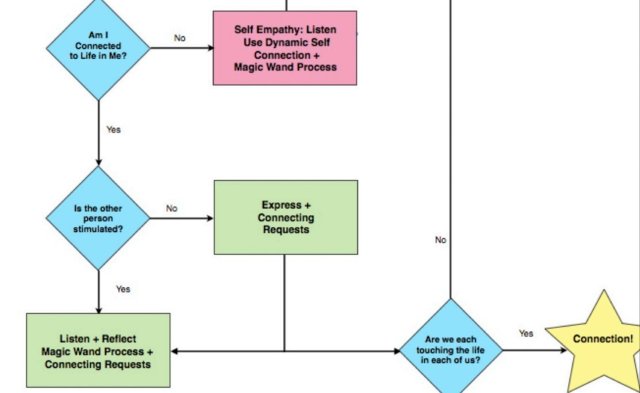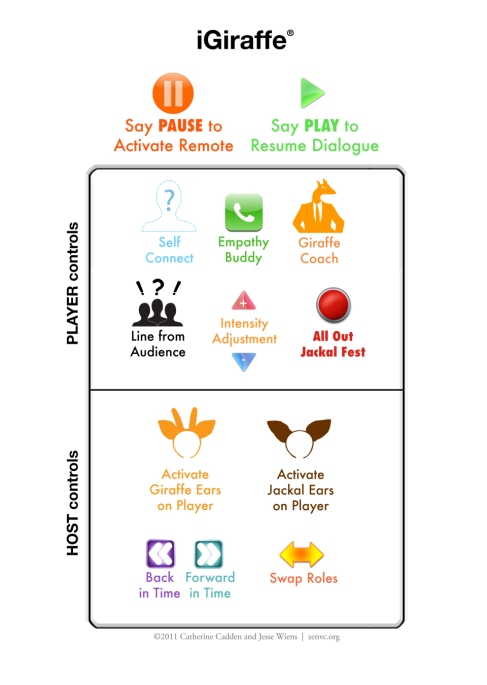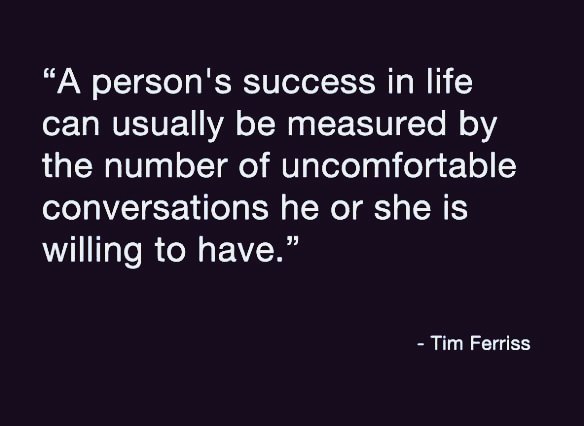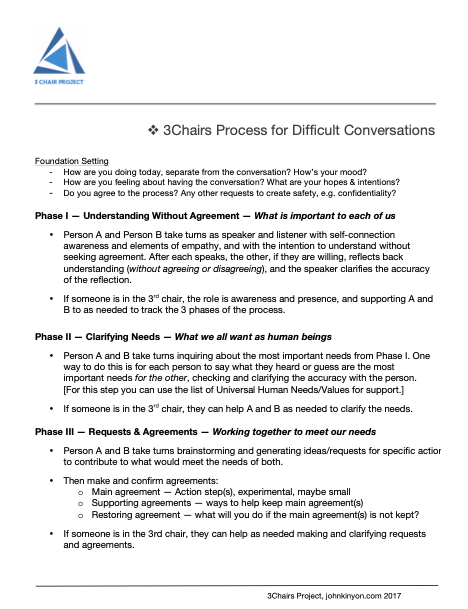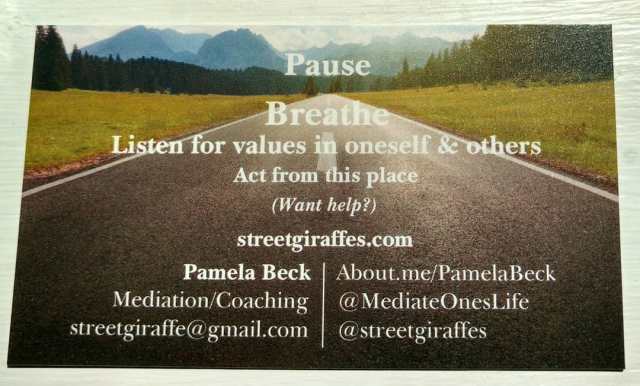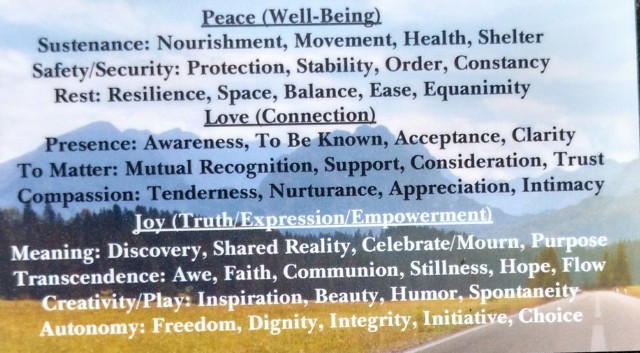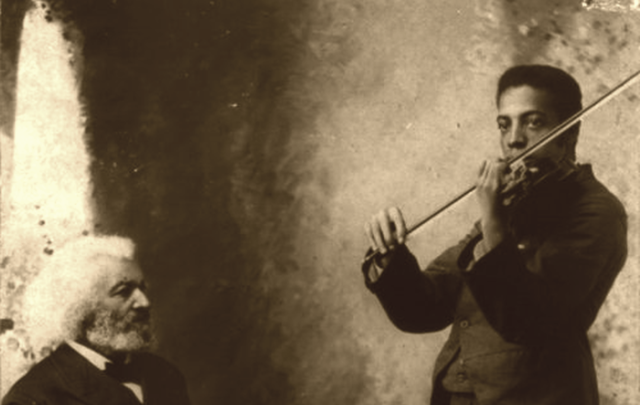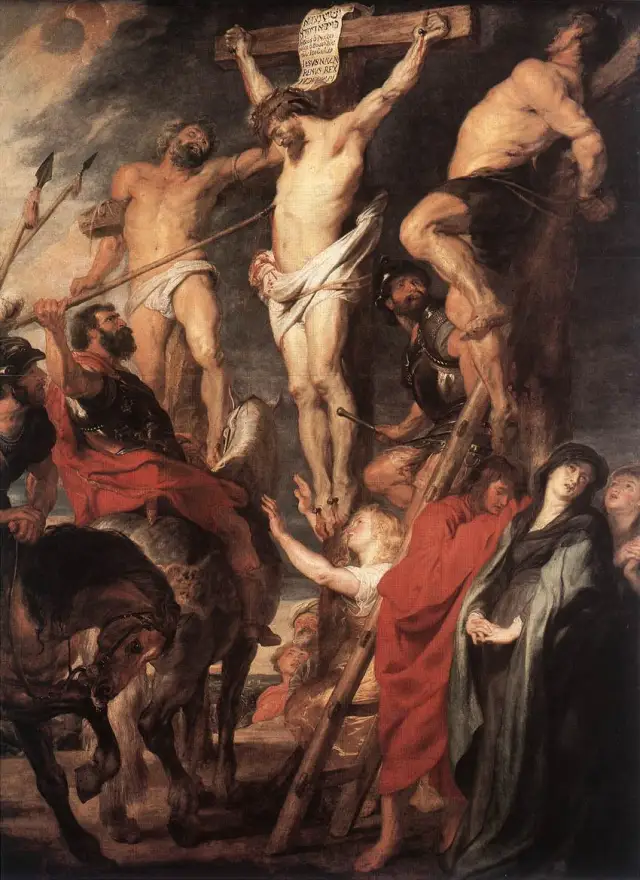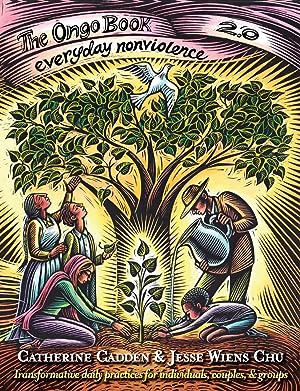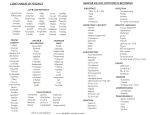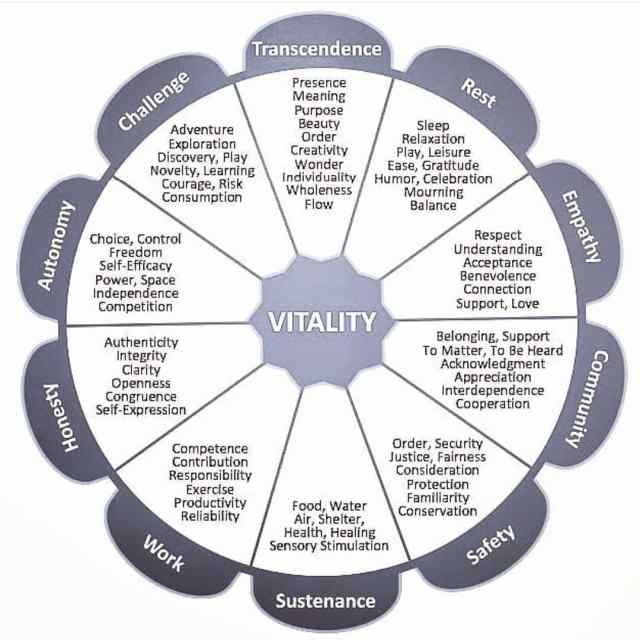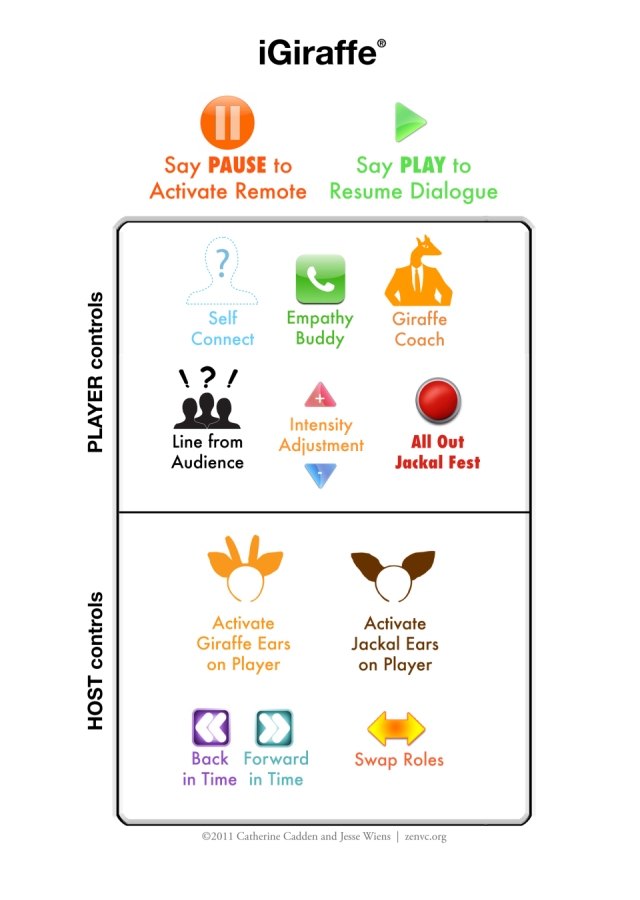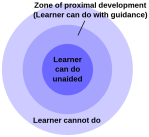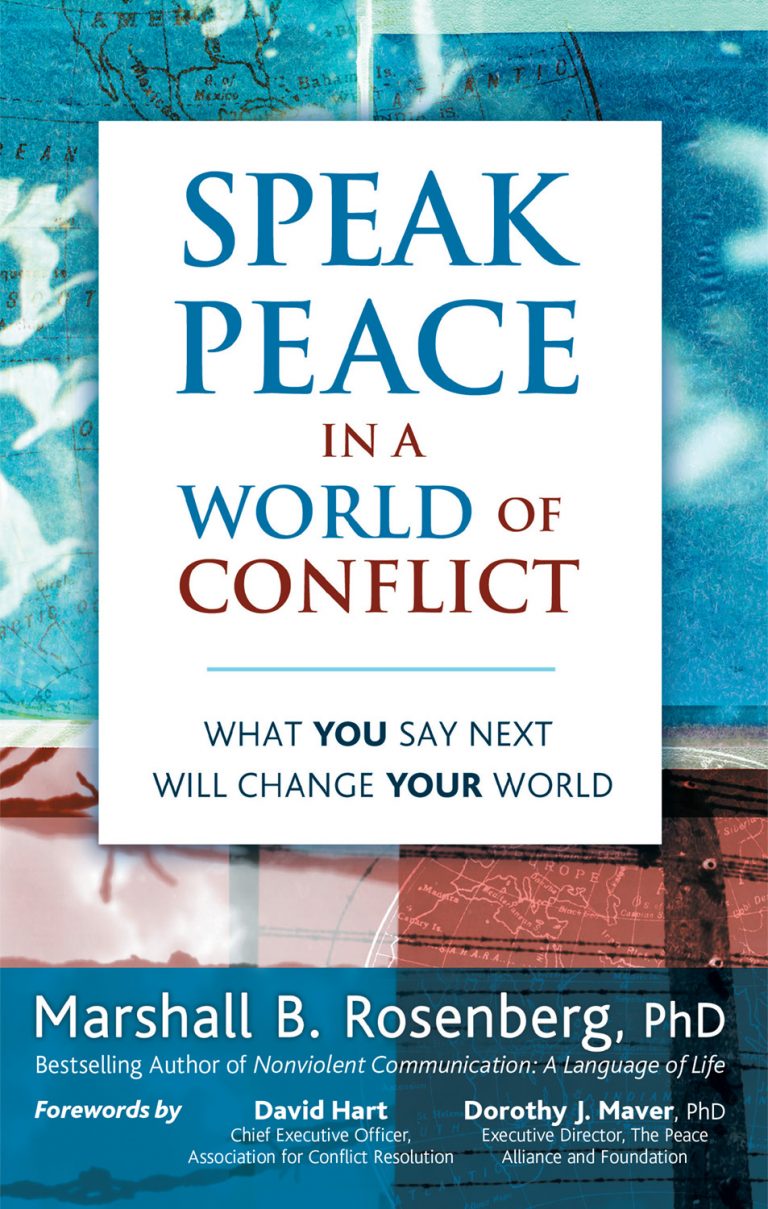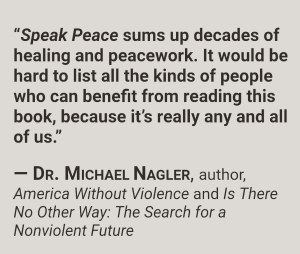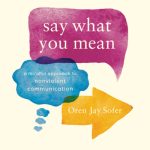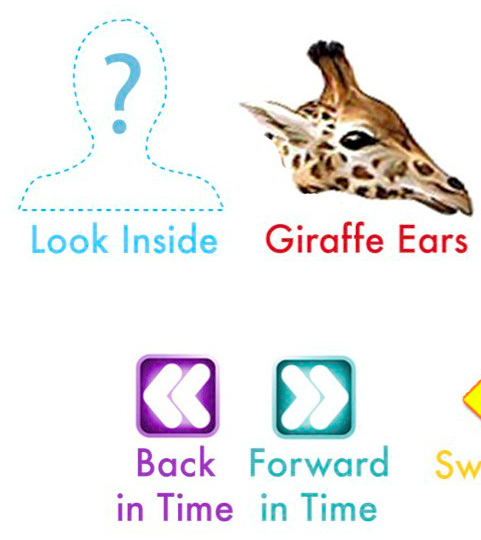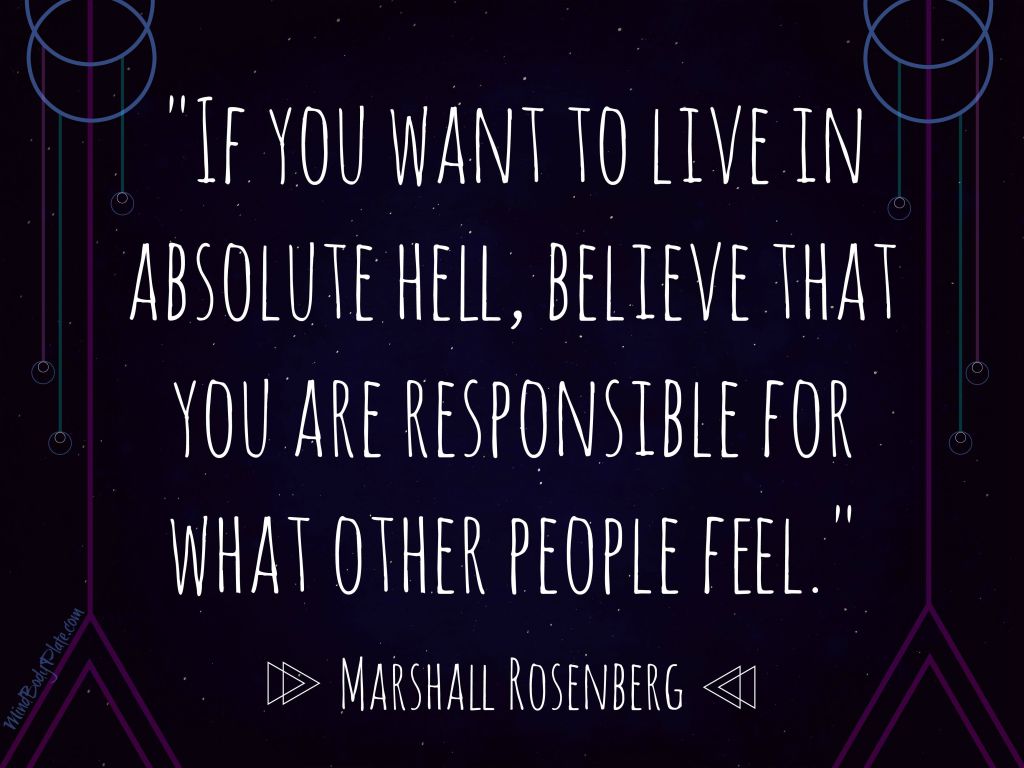Phrasing Needs
Speak clearly, if you speak at all; carve every word before you let it fall.
~ Oliver Wendell Holmes
(More on phrasing needs from Miki between 13 – 23:30 minute mark)
Naturalizing the Language of NVC – NVC Marketplace
Via the work of Miki Kashtan: “To focus on another challenging line to walk in learning to have fluidity in our communication. It’s the line that separates strategies from needs while still maintaining relevant contextual specificity in the choice of words for needs. (Have a copy of the needs list available as you do this activity so as to enjoy variety.) Collect a variety of situations in which you are very clear what the preferred strategy is for you or for someone else. For each of them, do the following steps: 1) Write down the strategy minus any evaluation or demand, just exactly what you or the other person wants; 2) Find the need that seems the most relevant to you for this strategy. If this is your preferred strategy, you can usually fully identify the need. If it’s another person’s preferred strategy, just write down your best guess. This will almost always be just one word from the needs list: autonomy, respect, competence, love, meaning, etc. 3) Find a full phrase consisting of a few words that is specific enough to fit the context and yet is still clearly a need and not a strategy. For example, the needs-phrase of ‘harmony with family members’ vs. the need (word) of ‘harmony’ – and not (the strategy) “to get along with my family.”

Colloquial-Giraffe
with Miki Kashtan
Excerpt:
#2 — Shifting from “one-word” needs to the “full-phrase” needs. This shift supports a greater sense of flow and provides more specific context to what we are saying while still maintaining the distinction between need and strategy.
E.g. in the previous example, we might expand the “one-word” need respect into the “full-phrase” need as follows: “Are you frustrated because you want to be respected for your point of view even when there is a disagreement?”
#3 — Eliminating the explicit link between feelings and needs through the use of the word ‘because’ in the classical template construction. In this case it’s a conceptual barrier, not simply a linguistic one. The understanding that feelings arise from needs is not widespread, and the use of this language often renders the speech awkward and confusing to others. A solution could either be dividing the expression into two sentences, or dropping the focus on feelings altogether and focusing only on the needs.
E.g. in the previous example, we might drop the word ‘because’ as follows: “[Are you frustrated?] Do you want to be respected for your point of view even when there is a disagreement?”
Full-Phrase-Need
Practice Steps:
1) Scenario; 2) Preferred Strategy; 3) [Universal] Need; 4) Phrase
[UNIVERSAL] NEED-to-PHRASE

E.g.
Need (word) – Effectiveness
Need-Phrase – Effectiveness of a crisp message

Dr. Martin Luther King, Jr. speaking at the Civil Rights March on Washington, Aug. 28, 1963.
(Credit: Army images)
Alternate Need-Phrase – Effectiveness of large numbers

Martin Luther King Jr. addresses a crowd from the steps of the Lincoln Memorial where he delivered his famous, “I Have a Dream,” speech during the Aug. 28, 1963, march on Washington, D.C. (Credit: Marines via Wiki)
Example:
1) Scenario: Marshall Rosenberg developed a communication process in the 1960s.[3]
2) Preferred Strategy: Rosenberg opted to call it “Nonviolent Communication”
3) [Universal Human] Need: __________ – Needs List
4) Phrase: _______________________
Inquiry: What Need [#3] and/or Full-Need Phrase [#4] best captures why Marshall Rosenberg might have chosen the name “Nonviolent Communication” [#2] to refer to the dialogue process he developed in the 1960s which paralleled the civil rights & nonviolent resistance movements of that era [#1]?
Via the CNVC.org website:
Nonviolent Communication (NVC) is based on the principles of nonviolence — the natural state of compassion when no violence is present in the heart. NVC begins by assuming that we are all compassionate by nature and that violent strategies—whether verbal or physical—are learned behaviors taught and supported by the prevailing culture. NVC also assumes that we all share the same, basic human needs, and that each of our actions are a strategy to meet one or more of these needs. People who practice NVC have found greater authenticity in their communication, increased understanding, deepening connection and conflict resolution.

President Lyndon B. Johnson meets with Martin Luther King, Jr. at the signing of the Voting Rights Act of 1965
(Credit: Yoichi Okamoto via Wikimedia Commons)
Courtesy of ~ Need vs. Strategy or request – NVCWiki
Need vs. Strategy or request
| Need | Strategy / Request |
| Abstract, no reference to a specific person, action or time | Specific, doable, observable behaviour |
| Needs are a-scriptive, it is difficult to put words on what is also described as “the universal energy that connects all of us”. Need language is probably the closest we can get to verbally describe this universal energy. | Descriptive |
| What I want to have fulfilled | What I want others or myself to do |
Miki Kashtan & The Fearless Heart – Home | Facebook
Phrase to exclude all tangibles, i.e. PLATO – Person, Location, Action, Time or Object
Via Miki Kashtan (re: needs vs. strategies):Needs lists, how to say this, is intrinsically an approximation, and the reason for that is because it’s isolated concepts, and life is fluid — so whether or not something is a need, some people start getting into kind of hairy conversations about whether this is a need or not. And, for me, what matters is two things, one is to ensure that what I’m talking about is clearly not attached to specific strategies. And there is an acronym that someone came up with that helps with that distinction. The acronym is Plato. Like the philosopher Plato and it stands for:
| PLATO: | |
|
Person
Location
Action
Time
Object
|
If you have any one of those five in what you are imagining is a need, you know that it is a strategy, because it is in material reality. So that’s one thing. Once you’ve taken all of those things out, you know that you are not in a particular strategy and you’re more likely to be in the energetic, spiritual, gestalt of the need, and then — from there on — the second question is — “if this is sufficiently deep to find the self-connection that I want?” So, for example, I can say that Comfort is a Need, but for me personally (I’m not saying for anyone else), most of the time (not even always) if I look inside to understand myself and what I come up with a need for comfort, it doesn’t feel like the end of a journey, it’s not really something I can go like ‘oh, yes that’s it I feel connected’ — than I keep inquiring and go deeper, but if it is sufficient than it’s a need, I don’t care what anyone else says, but in this moment it is a need.

(Beneath courtesy of the work of Miki Kashtan)
Utilizing “Universal-Need-Full-Phrase” in Role Plays:
1. Engage in more role plays — here’s the basic outline:
a. In a particular scenario, think of your preferred strategy, and translate it into a full-phrase need.
i. Find the underlying need that is expressed through this strategy.
ii. Fit this need into a full-phrase need that is specific to the context and the truth of the moment without including specific people, location, action, time, or object [PLATO].
iii. If you find that elements of strategy are still present, look for a deeper need that is informing the need you previously identified. For example, sometimes clarity can be a strategy for safety. Once you find a deeper need, it will usually be easier to find a strategy free contextualized full-phrase need.b. Communicate as fluidly as possible to your dialogic/role-play partner as that other person. Remember to include a request.
c. Have your dialogic/role-play partner respond as the other person, without use of NVC.
d. Apply the same process to what the other person says to respond empathically:
i. Find a full-phrase need underlying whatever they said, be it strategy, judgment, demand, or anything else.
ii. Put that need in an empathic guess without the words feeling or need.e. Continue in this slow-motion kind of dialogue, choosing empathy or expression in each round.
2. Offer each other empathy for whatever you want that kind of attention, and every few moments pause the process and find the full-phrase need that would fit the context. Once you reach fluency, the goal is to focus on full-phrase need language most of the time.
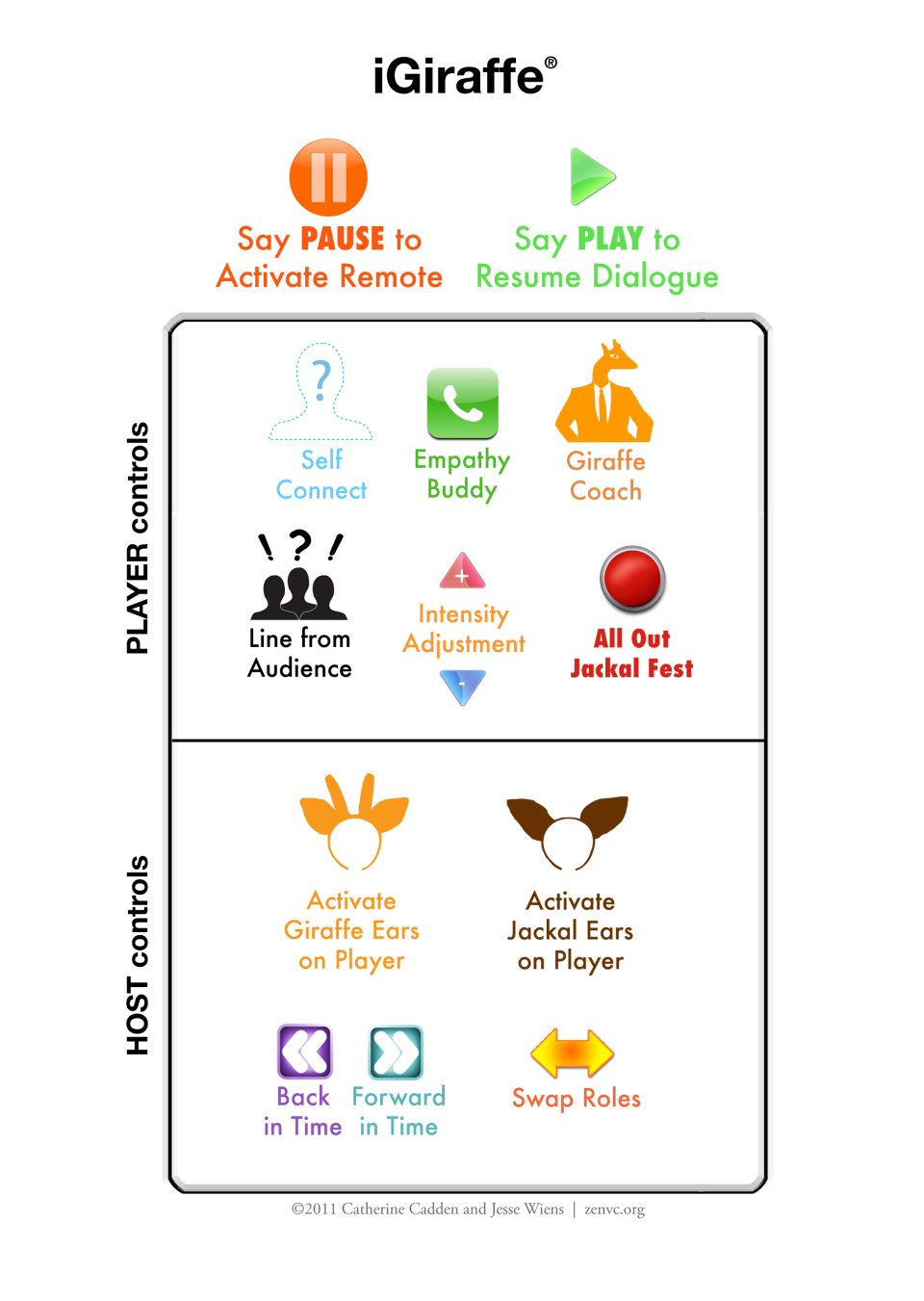
Example of Full-Phrase-Need: 9/11

“Unattributed” 9/11 Photographs
I think what has happened, actually, is that September 11 has given a spur, a renewed urgency, to dialogue between the great faiths. George Carey
Example (try it out yourself!):
Step One:
9/11
(Scenario)
Step Two:
Preferred Strategy – _______________
(Pick One – Yours/Another’s and/or Beneath’s):
Giuliani, Go Shopping, ABC, 9/12 – YouTube
Did Bush Tell Americans to ‘Go Shopping‘ After 9/11?
Toni Morrison’s preferred strategy (writing a poem):
The Dead of September 11 – poem by Toni Morrison
Step Three:
Need – _________
(What are human needs in Nonviolent Communication?)
Step Four:
Phrase – ______________________
(Excluding ‘PLATO’ – i.e. Person, Location, Action, Time, Object)
Russian figure skater wins gold with program that included audio from 9/11
American travel writer Paul Theroux on the meaning of 9/11:![]() You remember exactly where you were the day the planes hit the World Trade Center, that sudden smoking vastation in the Emerald City, persisting to this day as an inerasable vision of death: horror in instalments. It began in the morning. I was in my car on Cape Cod, returning from the town dump, a beautiful day of blue sky and marine sunlight, listening to a bewildered man on the radio trying to explain to a normally jolly talk show host the inexplicable crash he had just seen from the window of his flat. “This plane, I dunno, it just slammed into the tower, never seen anything like it.” And not long afterwards, the second plane hit. We watched, stupefied – it was immediately a television event in real time – and we were bewildered; no one had the slightest idea of why it had happened or what was to come. It was a day scorched by death – flames, screams, sirens, confusion, fear and extravagant rumours (“The Golden Gate Bridge has been hit, Seattle is bracing”). Read the rest of Paul’s piece here.
You remember exactly where you were the day the planes hit the World Trade Center, that sudden smoking vastation in the Emerald City, persisting to this day as an inerasable vision of death: horror in instalments. It began in the morning. I was in my car on Cape Cod, returning from the town dump, a beautiful day of blue sky and marine sunlight, listening to a bewildered man on the radio trying to explain to a normally jolly talk show host the inexplicable crash he had just seen from the window of his flat. “This plane, I dunno, it just slammed into the tower, never seen anything like it.” And not long afterwards, the second plane hit. We watched, stupefied – it was immediately a television event in real time – and we were bewildered; no one had the slightest idea of why it had happened or what was to come. It was a day scorched by death – flames, screams, sirens, confusion, fear and extravagant rumours (“The Golden Gate Bridge has been hit, Seattle is bracing”). Read the rest of Paul’s piece here.
Specific Example:
Step One:
9/11

(Credit: Wally Gobetz)
Step Two:
The tyranny of a prince in an oligarchy is not so dangerous to the public welfare as the apathy of a citizen in a democracy. ~ Charles de Montesquieu
Preferred Strategy:
Imbue U.S. w/ Historical Knowledge of Other Fateful 9/11s
(i.e. date’s varied meaning, throughout the world, in the past century)
A Fateful Day: 9/11 Also Marks Important Anniversaries
On the anniversary of the 2001 attacks on the World Trade Center and the Pentagon, we look back at several national and international events linked to that day. This year on September 11, India will mark the 105th anniversary of Mahatma Gandhi launching the modern nonviolent resistance movement. We play part of a 2003 interview with Gandhi’s grandson, Arun… (continues – link above)
Step Three:
Need ~ AWARENESS
-
knowledge or perception of a situation or fact.
“we need to raise public awareness of the issue”
synonyms: consciousness, recognition, realization;
Step Four:
Phrase: AWARENESS of our SHADOW
Carl Jung on Accepting the Darkness of Self and Others
The shadow is a moral problem that challenges the whole ego-personality, for no one can become conscious of the shadow without considerable moral effort. To become conscious of it involves recognizing the dark aspects of the personality as present and real. This act is the essential condition for any kind of self-knowledge.
Jung on the Shadow: Aion (1951). CW 9, Part II: P.14
| 1973 Chilean coup d’état | |
|---|---|
| U.S. intervention in Chile’s September 11, 1973 coup | |
 Bombardment of La Moneda Palace. Bombardment of La Moneda Palace. |
Kissinger Telcons on Chile
When Nixon notes that “our hand doesn’t show on this one though,” Kissinger responds that “We didn’t do it” [referring to the coup itself]. I mean we helped them….created the conditions as great as possible.”
(Listen to recording of quote beneath, above)
“He [Ambassador Korry] was — he was instructed to — but he just failed the son-of-a-bitch, that was his main problem, he should have kept Allende from getting in.” ~ Nixon
Another 9/11 Anniversary: September 11, 1973 – Democracy Now!
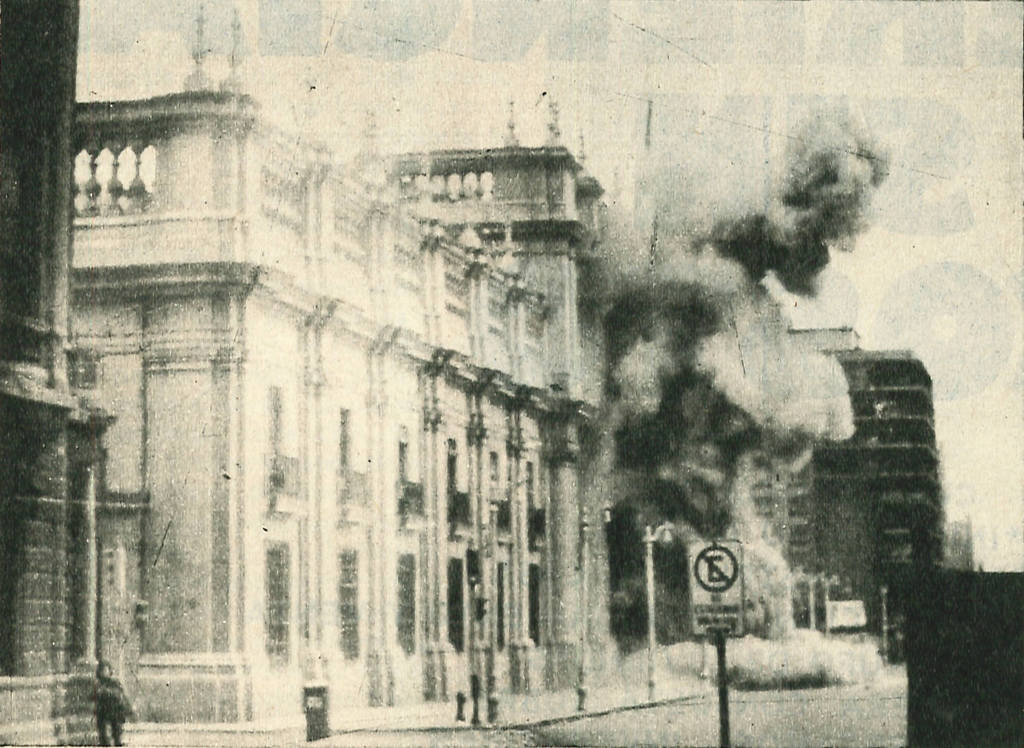
Coup of September 11, 1973. Bombing of La Moneda (presidential palace)
(Credit: Biblioteca del Congreso Nacional via Wiki)
THE LAST SEPTEMBER 11
by Ariel Dorfman (penned October 3rd 2001)
I have been through this before.
During the last 28 years, Tuesday, Sept. 11, has been a date of mourning, for me and millions of others, ever since that day in 1973 when Chile lost its democracy in a military coup, that day when death irrevocably entered our lives and changed us forever. And now, almost three decades later, the malignant gods of random history have wanted to impose upon another country that dreadful date, again a Tuesday, once again an 11th of September filled with death…(continues)
Epitaph for Another 9/11: Writer Ariel Dorfman- Democracy Now!
Chile and the United States: Declassified Documents
WASHINGTON D.C. – President Richard Nixon acknowledged that he had given instructions to “do anything short of a Dominican-type action” to keep the democratically elected president of Chile from assuming office, according to a White House audio tape posted by the National Security Archive. A phone conversation captured by his secret Oval Office taping system reveals Nixon telling his press secretary, Ron Zeigler, that he had given such instructions to then U.S. Ambassador Edward Korry, “but he just failed, the son of a bitch…. He should have kept Allende from getting in.”
The Pinochet File: A Declassified Dossier on Atrocity and Accountability – READ THE INTRODUCTION
A Los Angeles Times BEST NONFICTION BOOK of 2003
Publicly:
“We shall support vigorously the principle that no country has the right to impose its will or rule on another country by force…” ~ Nixon
Second Inaugural Address, 1973 . Nixon
Privately:
Nixon notes that “our hand doesn’t show on this one though…”
Missing – (Original Trailer) – Turner Classic Movies
USATODAY.com:
In a subsequent conversation about Allende, Secretary of State Rogers agreed with Kissinger that “we ought, as you say, to cold-bloodedly decide what to do and then do it.” Rogers warned that it should be done “discreetly so that it doesn’t backfire.”
“No matter what we do it will probably end up dismal,” said Rogers.
Was U.S. Journalist Charles Horman Killed by Chile’s Coup Regime With Aid from his own Government?
“Make the Economy Scream”: Secret Documents Show Nixon, Kissinger Role Backing 1973 Chilean Coupe
Hear/Read the Documents – The Pinochet File
l) White House Audio Tape, President Richard M. Nixon and White House press secretary Ron Zeigler, March 23, 1972
This audio clip is available in several formats:
Windows Media Audio – Broadband (1.1 MB – Streaming)
Windows Media Audio – Dial-up/56kb (298 KB – Streaming)
MP3 – (569 KB – Does not stream]In this White House tape, President
Nixon is recorded on March 23, 1972, speaking by phone to his White House press secretary, Ron Zeigler about damage control efforts on the first major covert operations scandal of the 1970s-the ITT papers on Chile. Zeigler reports on a State Department press conference held earlier in the afternoon. He tells the president that the key issue was an ITT memo that stated that in the fall of 1970, U.S. Ambassador Edward Korry had received a “green light” from the White House to “do everything short of a Dominican Republic-type action” to stop Allende. Nixon demands to know how that leaked out, and then emphatically states that Korry “was instructed” to do that. The President then scapegoats the Ambassador for failing to carry out those instructions. Numerous declassified records make it clear that Nixon and Kissinger explicitly ordered the CIA not to inform Ambassador Korry of their efforts to instigate a military coup to keep Allende from assuming office…(continues – The National Security Archive’s Chile Documentation Project)
[W]e’re going to give Allende the hook – nixontapes.org – Nixon
“I don’t see why we need to stand by and watch a country go communist due to the irresponsibility of its people. The issues are much too important for the Chilean voters to be left to decide for themselves.” Henry A. Kissinger
Lyrics (excerpted):
Hey Mr. Pinochet
You’ve sown a bitter crop
It’s foreign money that supports you
One day the money’s going to stop
No wages for your torturers
No budget for your guns
Background of Song by Sting
Background (via Wikipedia): The Nothing Like the Sun album was influenced by two events in Sting’s life: first, the death in late 1986 of his mother, which contributed to the sombre tone of several songs; and second, his participation in the Conspiracy of Hope Tour on behalf of Amnesty International, which brought Sting to parts of Latin America that had been ravaged by civil wars, and introduced him to victims of government oppression. “They Dance Alone (Cueca Solo)” was inspired by his witnessing of public demonstrations of grief by the wives and daughters of men missing in Chile, tortured and murdered by the military dictatorship of the time, who danced the cueca (the traditional dance of Chile) by themselves, with photos of their loved ones pinned to their clothes.
Via Wikipedia: The song is a metaphor referring to mourning Chilean women (arpilleristas) who dance the Cueca, the national dance of Chile, alone with photographs of their disappeared loved ones in their hands.
The Pinochet File:
How U.S. Politicians, Banks & Corporations Aided Chilean Coup, Dictatorship
40 Years After Chilean Coup, Allende Aide Juan Garcés on How He Brought Pinochet to Justice
The Other September 11 – Forbes
James S. Henry – I report on global issues as an economist, attorney and journalist. Almost every American, and indeed many non-Americans, can remember exactly where he or she was on September 11, 2001… (continues) Excerpt: But it is also very important to put our own “9/11″ in context. Unfortunately for me, this is not the only September 11 that is etched indelibly in my memory. Nor is it the only 9/11 event in the history of international terrorism that has claimed more than 3000 victims. In the first case noted above, Americans were among the nearly 3000 terror victims. In the second case described below, however, it is disturbing to recall that the US Government actually helped to cause them – at least 3065 dead and disappeared, and thousands more who were tortured. In this hour of remembrance, as we recall our own fallen victims of terror, let us also have the strength of character, compassion, and honesty to look this history in the eye, and recall these other victims of terror. This will not be easy. But it may help us to prevent a recurrence of the unself-critical, self-righteous, and ultimately self-defeating retributive excesses that we’ve seen throughout this very painful decade… (continues)
Part 2, Chapter 3: States of Shock | Naomi Klein

My cat watching Evgenia
Exploring musical responses to 9/11 | Music | The Guardian
Art Garfunkel: A song about the “inability of people to communicate with one another, not particularly internationally, but especially emotionally, so that what you see around you is people who are unable to love each other. This is called The Sound of Silence.“











